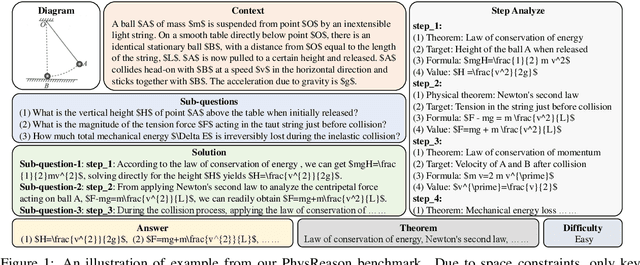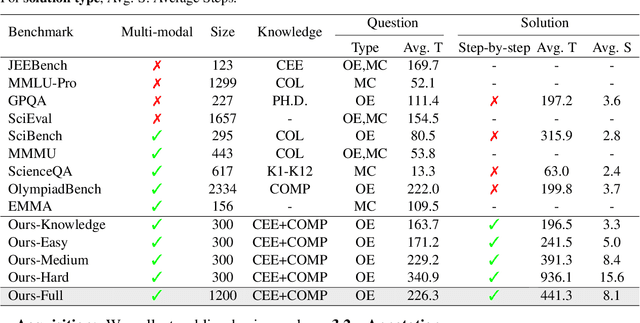Jiaxing Huang
Improving large language models with concept-aware fine-tuning
Jun 09, 2025Abstract:Large language models (LLMs) have become the cornerstone of modern AI. However, the existing paradigm of next-token prediction fundamentally limits their ability to form coherent, high-level concepts, making it a critical barrier to human-like understanding and reasoning. Take the phrase "ribonucleic acid" as an example: an LLM will first decompose it into tokens, i.e., artificial text fragments ("rib", "on", ...), then learn each token sequentially, rather than grasping the phrase as a unified, coherent semantic entity. This fragmented representation hinders deeper conceptual understanding and, ultimately, the development of truly intelligent systems. In response, we introduce Concept-Aware Fine-Tuning (CAFT), a novel multi-token training method that redefines how LLMs are fine-tuned. By enabling the learning of sequences that span multiple tokens, this method fosters stronger concept-aware learning. Our experiments demonstrate significant improvements compared to conventional next-token finetuning methods across diverse tasks, including traditional applications like text summarization and domain-specific ones like de novo protein design. Multi-token prediction was previously only possible in the prohibitively expensive pretraining phase; CAFT, to our knowledge, is the first to bring the multi-token setting to the post-training phase, thus effectively democratizing its benefits for the broader community of practitioners and researchers. Finally, the unexpected effectiveness of our proposed method suggests wider implications for the machine learning research community. All code and data are available at https://github.com/michaelchen-lab/caft-llm
SIGMA: Refining Large Language Model Reasoning via Sibling-Guided Monte Carlo Augmentation
Jun 06, 2025Abstract:Enhancing large language models by simply scaling up datasets has begun to yield diminishing returns, shifting the spotlight to data quality. Monte Carlo Tree Search (MCTS) has emerged as a powerful technique for generating high-quality chain-of-thought data, yet conventional approaches typically retain only the top-scoring trajectory from the search tree, discarding sibling nodes that often contain valuable partial insights, recurrent error patterns, and alternative reasoning strategies. This unconditional rejection of non-optimal reasoning branches may waste vast amounts of informative data in the whole search tree. We propose SIGMA (Sibling Guided Monte Carlo Augmentation), a novel framework that reintegrates these discarded sibling nodes to refine LLM reasoning. SIGMA forges semantic links among sibling nodes along each search path and applies a two-stage refinement: a critique model identifies overlooked strengths and weaknesses across the sibling set, and a revision model conducts text-based backpropagation to refine the top-scoring trajectory in light of this comparative feedback. By recovering and amplifying the underutilized but valuable signals from non-optimal reasoning branches, SIGMA substantially improves reasoning trajectories. On the challenging MATH benchmark, our SIGMA-tuned 7B model achieves 54.92% accuracy using only 30K samples, outperforming state-of-the-art models trained on 590K samples. This result highlights that our sibling-guided optimization not only significantly reduces data usage but also significantly boosts LLM reasoning.
Multimodal Reasoning Agent for Zero-Shot Composed Image Retrieval
May 26, 2025Abstract:Zero-Shot Composed Image Retrieval (ZS-CIR) aims to retrieve target images given a compositional query, consisting of a reference image and a modifying text-without relying on annotated training data. Existing approaches often generate a synthetic target text using large language models (LLMs) to serve as an intermediate anchor between the compositional query and the target image. Models are then trained to align the compositional query with the generated text, and separately align images with their corresponding texts using contrastive learning. However, this reliance on intermediate text introduces error propagation, as inaccuracies in query-to-text and text-to-image mappings accumulate, ultimately degrading retrieval performance. To address these problems, we propose a novel framework by employing a Multimodal Reasoning Agent (MRA) for ZS-CIR. MRA eliminates the dependence on textual intermediaries by directly constructing triplets, <reference image, modification text, target image>, using only unlabeled image data. By training on these synthetic triplets, our model learns to capture the relationships between compositional queries and candidate images directly. Extensive experiments on three standard CIR benchmarks demonstrate the effectiveness of our approach. On the FashionIQ dataset, our method improves Average R@10 by at least 7.5\% over existing baselines; on CIRR, it boosts R@1 by 9.6\%; and on CIRCO, it increases mAP@5 by 9.5\%.
R1-ShareVL: Incentivizing Reasoning Capability of Multimodal Large Language Models via Share-GRPO
May 22, 2025Abstract:In this work, we aim to incentivize the reasoning ability of Multimodal Large Language Models (MLLMs) via reinforcement learning (RL) and develop an effective approach that mitigates the sparse reward and advantage vanishing issues during RL. To this end, we propose Share-GRPO, a novel RL approach that tackle these issues by exploring and sharing diverse reasoning trajectories over expanded question space. Specifically, Share-GRPO first expands the question space for a given question via data transformation techniques, and then encourages MLLM to effectively explore diverse reasoning trajectories over the expanded question space and shares the discovered reasoning trajectories across the expanded questions during RL. In addition, Share-GRPO also shares reward information during advantage computation, which estimates solution advantages hierarchically across and within question variants, allowing more accurate estimation of relative advantages and improving the stability of policy training. Extensive evaluations over six widely-used reasoning benchmarks showcase the superior performance of our method. Code will be available at https://github.com/HJYao00/R1-ShareVL.
R1-Compress: Long Chain-of-Thought Compression via Chunk Compression and Search
May 22, 2025Abstract:Chain-of-Thought (CoT) reasoning enhances large language models (LLMs) by enabling step-by-step problem-solving, yet its extension to Long-CoT introduces substantial computational overhead due to increased token length. Existing compression approaches -- instance-level and token-level -- either sacrifice essential local reasoning signals like reflection or yield incoherent outputs. To address these limitations, we propose R1-Compress, a two-stage chunk-level compression framework that preserves both local information and coherence. Our method segments Long-CoT into manageable chunks, applies LLM-driven inner-chunk compression, and employs an inter-chunk search mechanism to select the short and coherent sequence. Experiments on Qwen2.5-Instruct models across MATH500, AIME24, and GPQA-Diamond demonstrate that R1-Compress significantly reduces token usage while maintaining comparable reasoning accuracy. On MATH500, R1-Compress achieves an accuracy of 92.4%, with only a 0.6% drop compared to the Long-CoT baseline, while reducing token usage by about 20%. Source code will be available at https://github.com/w-yibo/R1-Compress
Training-Free Text-Guided Image Editing with Visual Autoregressive Model
Mar 31, 2025Abstract:Text-guided image editing is an essential task that enables users to modify images through natural language descriptions. Recent advances in diffusion models and rectified flows have significantly improved editing quality, primarily relying on inversion techniques to extract structured noise from input images. However, inaccuracies in inversion can propagate errors, leading to unintended modifications and compromising fidelity. Moreover, even with perfect inversion, the entanglement between textual prompts and image features often results in global changes when only local edits are intended. To address these challenges, we propose a novel text-guided image editing framework based on VAR (Visual AutoRegressive modeling), which eliminates the need for explicit inversion while ensuring precise and controlled modifications. Our method introduces a caching mechanism that stores token indices and probability distributions from the original image, capturing the relationship between the source prompt and the image. Using this cache, we design an adaptive fine-grained masking strategy that dynamically identifies and constrains modifications to relevant regions, preventing unintended changes. A token reassembling approach further refines the editing process, enhancing diversity, fidelity, and control. Our framework operates in a training-free manner and achieves high-fidelity editing with faster inference speeds, processing a 1K resolution image in as fast as 1.2 seconds. Extensive experiments demonstrate that our method achieves performance comparable to, or even surpassing, existing diffusion- and rectified flow-based approaches in both quantitative metrics and visual quality. The code will be released.
R1-VL: Learning to Reason with Multimodal Large Language Models via Step-wise Group Relative Policy Optimization
Mar 17, 2025Abstract:Recent studies generally enhance MLLMs' reasoning capabilities via supervised fine-tuning on high-quality chain-of-thought reasoning data, which often leads models to merely imitate successful reasoning paths without understanding what the wrong reasoning paths are. In this work, we aim to enhance the MLLMs' reasoning ability beyond passively imitating positive reasoning paths. To this end, we design Step-wise Group Relative Policy Optimization (StepGRPO), a new online reinforcement learning framework that enables MLLMs to self-improve reasoning ability via simple, effective and dense step-wise rewarding. Specifically, StepGRPO introduces two novel rule-based reasoning rewards: Step-wise Reasoning Accuracy Reward (StepRAR) and Step-wise Reasoning Validity Reward (StepRVR). StepRAR rewards the reasoning paths that contain necessary intermediate reasoning steps via a soft key-step matching technique, while StepRAR rewards reasoning paths that follow a well-structured and logically consistent reasoning process through a reasoning completeness and logic evaluation strategy. With the proposed StepGRPO, we introduce R1-VL, a series of MLLMs with outstanding capabilities in step-by-step reasoning. Extensive experiments over 8 benchmarks demonstrate the superiority of our methods.
Strategic priorities for transformative progress in advancing biology with proteomics and artificial intelligence
Feb 21, 2025

Abstract:Artificial intelligence (AI) is transforming scientific research, including proteomics. Advances in mass spectrometry (MS)-based proteomics data quality, diversity, and scale, combined with groundbreaking AI techniques, are unlocking new challenges and opportunities in biological discovery. Here, we highlight key areas where AI is driving innovation, from data analysis to new biological insights. These include developing an AI-friendly ecosystem for proteomics data generation, sharing, and analysis; improving peptide and protein identification and quantification; characterizing protein-protein interactions and protein complexes; advancing spatial and perturbation proteomics; integrating multi-omics data; and ultimately enabling AI-empowered virtual cells.
Reasoning with Reinforced Functional Token Tuning
Feb 19, 2025Abstract:In this work, we propose Reinforced Functional Token Tuning (RFTT), a novel reinforced fine-tuning framework that empowers Large Language Models (LLMs) with self-play learn-to-reason capabilities. Unlike prior prompt-driven reasoning efforts, RFTT embeds a rich set of learnable functional tokens (e.g., <analyze>, <verify>, <refine>) directly into the model vocabulary, enabling chain-of-thought construction with diverse human-like reasoning behaviors. Specifically, RFTT comprises two phases: (1) supervised fine-tuning performs prompt-driven tree search to obtain self-generated training data annotated with functional tokens, which warms up the model to learn these tokens for reasoning; and (2) online reinforcement learning further allows the model to explore different reasoning pathways through functional token sampling without relying on prompts, thereby facilitating effective self-improvement for functional reasoning. Extensive experiments demonstrate the superiority of the proposed RFTT on mathematical benchmarks, significantly boosting Qwen-2.5-7B-Instruct (70.6% to 79.8%) and LLaMA-3.1-8B-Instruct (32.2% to 60.2%) on the MATH dataset. Moreover, the performance of RFTT consistently improves with more search rollouts at inference time. Our code is available at https://github.com/sastpg/RFTT.
PhysReason: A Comprehensive Benchmark towards Physics-Based Reasoning
Feb 17, 2025



Abstract:Large language models demonstrate remarkable capabilities across various domains, especially mathematics and logic reasoning. However, current evaluations overlook physics-based reasoning - a complex task requiring physics theorems and constraints. We present PhysReason, a 1,200-problem benchmark comprising knowledge-based (25%) and reasoning-based (75%) problems, where the latter are divided into three difficulty levels (easy, medium, hard). Notably, problems require an average of 8.1 solution steps, with hard requiring 15.6, reflecting the complexity of physics-based reasoning. We propose the Physics Solution Auto Scoring Framework, incorporating efficient answer-level and comprehensive step-level evaluations. Top-performing models like Deepseek-R1, Gemini-2.0-Flash-Thinking, and o3-mini-high achieve less than 60% on answer-level evaluation, with performance dropping from knowledge questions (75.11%) to hard problems (31.95%). Through step-level evaluation, we identified four key bottlenecks: Physics Theorem Application, Physics Process Understanding, Calculation, and Physics Condition Analysis. These findings position PhysReason as a novel and comprehensive benchmark for evaluating physics-based reasoning capabilities in large language models. Our code and data will be published at https:/dxzxy12138.github.io/PhysReason.
 Add to Chrome
Add to Chrome Add to Firefox
Add to Firefox Add to Edge
Add to Edge